CAA News Today
New in caa.reviews
posted by CAA — March 31, 2017
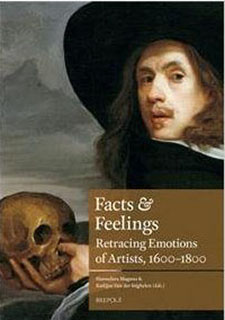 Stephanie S. Dickey reads Facts and Feelings: Retracing Emotions of Artists, 1600–1800, edited by Hannelore Magnus and Katlijne Van der Stighelen. The book’s goal “is not to gauge the expression of emotion in art, but instead to plumb the emotions of artists themselves.” Interestingly, “the visual record is mostly avoided in favor of documentary sources that find artists in emotionally charged situations.” Read the full review at caa.reviews.
Stephanie S. Dickey reads Facts and Feelings: Retracing Emotions of Artists, 1600–1800, edited by Hannelore Magnus and Katlijne Van der Stighelen. The book’s goal “is not to gauge the expression of emotion in art, but instead to plumb the emotions of artists themselves.” Interestingly, “the visual record is mostly avoided in favor of documentary sources that find artists in emotionally charged situations.” Read the full review at caa.reviews.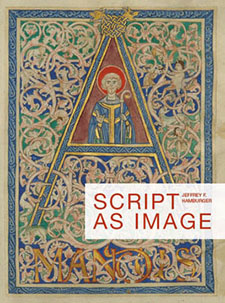 Eric Palazzo discusses Jeffrey F. Hamburger’s Script as Image, “a deeply engaging book, or rather a lengthy essay, on the ‘double page’ in the illuminated manuscripts of the Middle Ages.” The author starts “by exploring the possibility of considering writing as an image,” and “his approach focuses on a new exploration of the common nature of the written word and image” in visual culture. Read the full review at caa.reviews.
Eric Palazzo discusses Jeffrey F. Hamburger’s Script as Image, “a deeply engaging book, or rather a lengthy essay, on the ‘double page’ in the illuminated manuscripts of the Middle Ages.” The author starts “by exploring the possibility of considering writing as an image,” and “his approach focuses on a new exploration of the common nature of the written word and image” in visual culture. Read the full review at caa.reviews.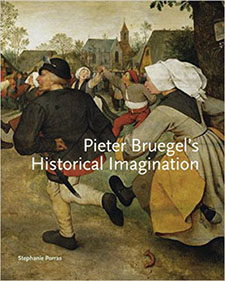 Arthur J. DiFuria reviews Pieter Bruegel’s Historical Imagination by Stephanie Porras. The “well-written, beautifully produced book” brings “a supremely important aspect of Bruegel’s art” to light, offering “a carefully considered take on his notion of the Netherlandish past” and portraying him “as an erudite artist who formulated a Netherlandish antiquarian vernacular.” Read the full review at caa.reviews.
Arthur J. DiFuria reviews Pieter Bruegel’s Historical Imagination by Stephanie Porras. The “well-written, beautifully produced book” brings “a supremely important aspect of Bruegel’s art” to light, offering “a carefully considered take on his notion of the Netherlandish past” and portraying him “as an erudite artist who formulated a Netherlandish antiquarian vernacular.” Read the full review at caa.reviews.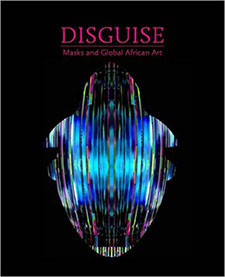 John P. Bowles examines the exhibition Disguise: Masks and Global African Art, curated by Pamela McClusky and Erika Dalya Massoquoi. The show and catalogue question “how African cultural traditions circulate and influence global contemporary art,” arguing that “the artists of ‘global Africa’ have begun to address this issue, changing how we understand African art.” Read the full review at caa.reviews.
John P. Bowles examines the exhibition Disguise: Masks and Global African Art, curated by Pamela McClusky and Erika Dalya Massoquoi. The show and catalogue question “how African cultural traditions circulate and influence global contemporary art,” arguing that “the artists of ‘global Africa’ have begun to address this issue, changing how we understand African art.” Read the full review at caa.reviews.CWA Picks for April 2017
posted by CAA — March 30, 2017
Each month, CAA’s Committee on Women in the Arts selects the best in feminist art and scholarship. The following exhibitions and events should not be missed. Check the archive of CWA Picks at the bottom of the page, as several museum and gallery shows listed in previous months may still be on view or touring.
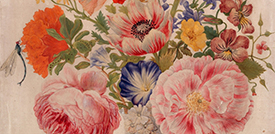
Maria Sibylla Merian, Chinese Vase with Roses, Poppies and Carnations, ca. 1670–1680 (photograph © Staatliche Museen zu Berlin, Kupferstichkabinett / Dietmar Katz)
Maria Sibylla Merian and the Tradition of Flower Illustration
Kupferstichkabinett, Berlin
Matthäikirchplatz, 10785 Berlin, Germany
April 7–July 3, 2017
Städel Museum in Frankfurt
Schaumainkai 63, 60596 Frankfurt am Main, Germany
October 11, 2017–January 14, 2018
Academic conference
University of Amsterdam
ARTIS Library, Plantage Middenlaan 45-45A, 1018 DC Amsterdam, Netherlands
June 7–9, 2017
In commemoration of the three hundredth anniversary of the death of the German-born illustrator and naturalist Maria Sibylla Merian, the Kupferstichkabinett in Berlin (April 7–July 2, 2017) and Städel Museum in Frankfurt (October 11–January 14, 2018) are sponsoring a joint show of approximately 150 of her works on paper and vellum. Known for her exquisite depictions of flowers and insects, Merian had an international reputation in her lifetime. Her illustrated texts include a volume of engravings of flora and fauna she produced while on a scientific expedition to the Dutch colony of Surinam in 1699. As a complement to this exhibition, the University of Amsterdam is sponsoring an academic conference titled “Changing the Nature of Art and Science: Intersections with Maria Sibylla Merian” (June 7–9, 2017), where her contributions to the history of printmaking, natural history, and botanical art will be honored.
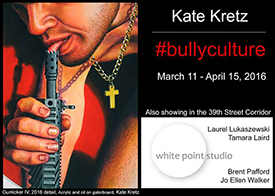
Invitation for Kate Kretz’s #bullyculture
Kate Kretz: #bullyculture
39th Street Gallery and Corridor Exhibition Space
Gateway Arts Center, 3901 Rhode Island Ave, Brentwood, Maryland
March 11–April 15, 2017
#bullyculture represents the first phase of an ambitious in-progress series that Kate Kretz commenced in 2011 and will conclude later this year. In her quest to find the common denominator to all the crimes against women, children, “minorities,” animals, and the earth, she has produced a large corpus of works on paper, sculpture, paintings, textiles, and mixed media. Some of the themes she explores in this series include “trophy hunting, VIP culture and ‘the 1%’, corporate destruction of the earth, rape culture and sexual entitlement, the fetishization of guns and their use for intimidation.” The artist, who has received numerous awards and grants, including the Southeastern College Art Conference’s 2016 award for Outstanding Artistic Achievement and a position on the Fulbright Specialist Roster through 2021, will be giving a lecture on April 1.
Shagha Ariannia: Who Sings the Nation-State?
Vincent Price Art Museum
East Los Angeles College, 1301 Avenida Cesar Chavez, Monterey Park, CA
March 18–June 10, 2017
A little over fifteen years ago, and one week after 9/11, Shagha Ariannia and her family arrived to Los Angeles as migrants from Iran. Ariannia has mined this particularly potent history of travel, place-finding, and identity-in-transit throughout her artistic career by, for example, annotating her family’s photographic archives in a series called What would America/Iran do without Iran/America? (2012). This solo exhibition focuses on a series of works Ariannia has been creating using national anthems from various countries (Iran and the United States included, among many others). In this way she takes seriously the titular question posed by Gayatri Spivak and Judith Butler in their 2007 dialogue Who Sings the Nation-State? As Butler says in that text, in regard to hearing the US national anthem sung in Spanish in the streets of Los Angeles, “The monolingual requirement of the nation surely surfaces in the refusal to hear the anthem sung in Spanish, but it does not make the anthem any less sing-able in that or any other language” (60).
Nina Katchadourian: Curiouser
Blanton Museum of Art
200 E. Martin Luther King Jr. Blvd., Austin, TX
March 12 – June 11, 2017
A few years ago I recall seeing a dozen or so clickbait-y articles written about Nina Katchadourian’s Lavatory Self-Portraits in the Flemish Style, a series in which the artist constructed toilet-paper and neck-pillow costumes during long-haul flights and photographed herself wearing them in the tiny, and poorly lit, spaces of onboard lavatories. This midcareer survey—the artist’s first touring museum exhibition—promises to flesh out Katchadourian’s wide-ranging work. The Flemish lavatory portraits, for example, are only one piece of a larger series of works using the airplane as studio space (Seat Assignment, 2010–ongoing). One of the works on display, and one of her most well-known, is the video Accent Elimination, wherein the artist hired a speech coach to teach her parents (both foreign born) to speak in a “standard” American accent, and, in turn, to teach her how to speak with her parents’ accent. Her collaborations with her family, other artists, international agencies, and even animals are potent reminders that the activity of art is almost never a solitary endeavor, and her interest in quotidian acts of creativity suggests that art can be found anywhere. One just has to know how to look.
May Stevens: Alice in the Garden
Ryan Lee Gallery
515 West 26th Street, New York, New York
February 23–April 8, 2017
May Stevens, a celebrated activist committed to the civil rights, antiwar, and feminist movements, used painting to combat social injustice and to revise women’s history throughout her seventy-year career. The exhibition Alice in the Garden comprises several large-scale paintings depicting Alice Dick Stevens, her elderly mother, during the final years of her life.
From 1983 and 1990, Stevens turned her attention to her mother and producing the five-panel painting Alice in the Garden (1988–89). “The mural-like images confront the viewer with the massive figure of Alice—fleshy, fragile, and vulnerable. In her hands, Alice manipulates flowers—dandelions Stevens had playfully thrown at her during an afternoon visit.”
In a conversation with the art historian Patricia Hills, Stevens explained the importance of Alice as a subject: “For me I think it means I want her [Alice] to be known, even for the individual person that she is, but it also means that I want people like that not to be forgotten. For me she’s not just a single person, because we all know this person. We all know her and we may become her. She’s a problem. As aging is a problem, as illness is a problem, as being a woman who does not fulfill herself is a problem.” (Patricia Hills, May Stevens [San Francisco: Pomegranate, 2005], 45.)
Today May Stevens, now 92, lives with Alzheimer’s disease in a memory-loss facility in New Mexico. She has received numerous awards including ten MacDowell Colony residencies, the Women’s Caucus for Art Lifetime Achievement Award (1990), a Guggenheim fellowship in painting (1986), a National Endowment for the Arts Fellowship in painting (1983), an Andy Warhol Foundation residency (2001), and CAA’s own Distinguished Artist Award for Lifetime Achievement (2001).
Terrains of the Body: Photography from the National Museum of Women in the Arts
Whitechapel Gallery
77-82 Whitechapel High St, London
January 18–April 16, 2017
Featuring over seventeen contemporary artists working across mediums, Terrains of the Body: Photography from the National Museum of Women in the Arts assembles an impressive collection from Washington, DC, for display across the water in London. “By turning their camera to women, including themselves, these artists embrace the female body as a vital medium for storytelling, expressing identity and reflecting individual and collective experience.”
Many works in the display extend the scope of 1970s feminist art, including performance and video. This display celebrates their legacy today. Moving between photography’s ability to document and tell stories, these works present women as creator and subject of their work. Several artists in the exhibition, including Nan Goldin and Daniela Rossell, photograph women in expansive series that appear documentary in nature. Other artists include Marina Abramović, Rineke Dijkstra, Anna Gaskell, Charlotte Gyllenhammar, Candida Höfer, Icelandic Love Corporation, Mwangi Hutter, Kirsten Justesen, Justine Kurland, Nikki S. Lee, Hellen van Meene, Shirin Neshat, Eve Sussman and the Rufus Corporation, Janaina Tschäpe, and Adriana Varejão.
News from the Art and Academic Worlds
posted by Christopher Howard — March 29, 2017
Each week CAA News summarizes eight articles, published around the web, that CAA members may find interesting and useful in their professional and creative lives.
Women’s Movement Impacts Spending on Art Supplies
The week before the Women’s March, sales of poster boards in the US were up 33 percent and foam boards by 42 percent versus the same week last year. Sales of easel pads/flip charts also grew, as did tools used to assist in making the poster messages, including paint markers, specialty markers, and permanent markers. (Read more from NPD Group.)
Gender Gap Persists at Largest Museums
When the director of the Metropolitan Museum of Art steps down in June, the top job at the biggest art museum in the US will be up for grabs. A woman faces long odds of landing that job, to judge from a study from the Association of Art Museum Directors. “The Ongoing Gender Gap in Art Museum Directorships” shows that just one of the nation’s thirteen largest museums is led by a woman. (Read more from the New York Times.)
Meet Art Girl Army, a Group of Female Creatives Fighting for Equal Opportunity
When Sydney Lowe invited a few girlfriends over to her small Brooklyn apartment in 2014, she didn’t know she was starting an army. Today she is the founder of Art Girl Army, a fast-growing collective of women creatives—including those who are gender nonconforming, transgender, and genderqueer—who make art, films, graphics, and music. And while they might not be armed with weapons, they certainly have missions. (Read more from Artsy.)
Seeking Grants: More Than Money
The need to succeed at getting grants is a continuing part of faculty life at research institutions. Watching the process leaves some graduate students and postdocs convinced that they want no part of it. The stakes seem so high. But bringing in outside funding is the only way to sustain an independent research-driven career in an academic setting. (Read more from Inside Higher Ed.)
Virtual Reality in the Art-History Classroom
I recently become fascinated with virtual reality and the realism I experience by viewing through a small boxlike device—in this case, Google Cardboard. I wondered if there could be connections made between virtual reality and my art-history survey course for students at Mount Saint Mary College. (Read more from Art History Teaching Resources.)
The American Government Is Searching for Its Own Lost Art
They are not America’s art police. There are no midnight raids, covert surveillance, or undercover operations. Most everything is done through cordial emails, polite phone calls, and, if necessary, civil court. While glamour is not top priority, make no mistake—the United States government wants its art back. (Read more from Atlas Obscura.)
Art Attack: Why Do People Try to Destroy Museum Masterpieces?
On March 18, a man “with no fixed abode” slashed Thomas Gainsborough’s The Morning Walk with a screwdriver at London’s National Gallery. He was quickly detained and the damage appears to be fixable—the paint was cut, but the screwdriver did not pierce the supporting canvas. Conservators are brilliant surgeons, and the scars should be invisible by the time they are done. (Read more from Salon.)
Dealing with Disrupters
As obstructionist protests of controversial speakers spread, some say the future of the trend depends on how colleges and universities respond—namely what, if any, disciplinary action they take against participants. But just what action to take, and when, is tricky business. (Read more from Inside Higher Ed.)
Laura Weigert Reviews Anne Teresa De Keersmaeker’s Work/Travail/Arbeid
posted by CAA — March 27, 2017
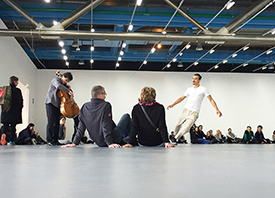
Anne Teresa De Keersmaeker, Work/Travail/Arbeid, performed by Rosas at the Centre Georges Pompidou, Paris, February 26–March 6, 2016 (choreography © Anne Teresa De Keersmaeker; photograph © Laura Weigert)
caa.reviews is pleased to announce the publication of a new multimedia reviews project on the Scalar platform: Anne Teresa De Keersmaeker’s Work/Travail/Arbeid by Laura Weigert. Weigert’s review of Work/Travail/Arbeid’s ten-day performance at the Centre Georges Pompidou in Paris from February 26 to March 6, 2016, is the starting point for this project, which also includes a conversation between De Keersmaeker and Weigert. The project features media explorations of the performances of Work/Travail/Arbeid at WIELS Contemporary Art Centre in Brussels and Tate Modern in London. The site will present additional media following Work/Travail/Arbeid performances at the Museum of Modern Art in New York from March 29 through April 2, 2017.
New in caa.reviews
posted by CAA — March 24, 2017
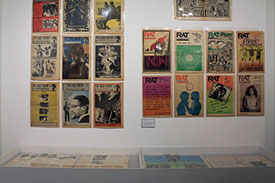 Katharine J. Wright reviews Realize Your Desires: Underground Press from the Library of Stefan Brecht, an exhibition at Printed Matter. It “brings to light an expansive private collection of underground newspapers dating from the mid-1960s through the early 1970s” and “proves both timely and enlightening” by providing “a rare glimpse into America’s troubled past.” Read the full review at caa.reviews.
Katharine J. Wright reviews Realize Your Desires: Underground Press from the Library of Stefan Brecht, an exhibition at Printed Matter. It “brings to light an expansive private collection of underground newspapers dating from the mid-1960s through the early 1970s” and “proves both timely and enlightening” by providing “a rare glimpse into America’s troubled past.” Read the full review at caa.reviews.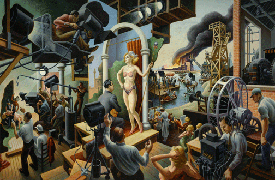 Stephen Caffey discusses the exhibition American Epics: Thomas Hart Benton and Hollywood, organized by the Peabody Essex Museum and Amon Carter Museum of American Art, and its catalogue. Featuring the artist’s best-known works “along with less familiar paintings,” the show “situates Benton’s artistic practice within the trajectories of two venerable traditions: the literary epic and the cinematic blockbuster.” Read the full review at caa.reviews.
Stephen Caffey discusses the exhibition American Epics: Thomas Hart Benton and Hollywood, organized by the Peabody Essex Museum and Amon Carter Museum of American Art, and its catalogue. Featuring the artist’s best-known works “along with less familiar paintings,” the show “situates Benton’s artistic practice within the trajectories of two venerable traditions: the literary epic and the cinematic blockbuster.” Read the full review at caa.reviews. Betty J. Crouther reads Mary Ann Carroll: First Lady of the Highwaymen by Gary Monroe. The author “builds Carroll’s story around her Highwaymen associations as well as quotations sprinkled generously throughout the text.” Although “readers will be grateful to Monroe for bringing attention to Carroll, they will also be frustrated that he documents so little.” Read the full review at caa.reviews.
Betty J. Crouther reads Mary Ann Carroll: First Lady of the Highwaymen by Gary Monroe. The author “builds Carroll’s story around her Highwaymen associations as well as quotations sprinkled generously throughout the text.” Although “readers will be grateful to Monroe for bringing attention to Carroll, they will also be frustrated that he documents so little.” Read the full review at caa.reviews.News from the Art and Academic Worlds
posted by Christopher Howard — March 22, 2017
Each week CAA News summarizes eight articles, published around the web, that CAA members may find interesting and useful in their professional and creative lives.
Could Blockchain Put Money Back in Artists’ Hands?
By registering artworks with blockchain to establish authenticity and create property rights which can then be split off and traded, argues Amy Whitaker, artists can retain an “equity share” in their works, much like the founder of a startup retains an ownership stake that grows in value as the company expands. (Read more from Artsy.)
Report from the 2016 Craft Think Tank
Last June the Center for Craft, Creativity, and Design convened a two-day, special-topic Craft Think Tank, bringing together experts across disciplines to assess the state of craft in academia. The group discussed and made recommendations concerning the content, format, approach, audience, and resources needed to create a relevant and successful program. (Read more from the Center for Craft, Creativity, and Design.)
Detroit Exits Bankruptcy, Thanks to Its Art Museum
A federal judge approved Detroit’s bankruptcy plan, allowing the city government to hit the reset button after years of financial mismanagement. The bankruptcy could have been far lengthier, and even more painful for retirees, had it not been for an unusual deal designed to save the Detroit Institute of Arts while minimizing cuts to pensions. (Read more from Slate.)
The Skillful Curator: A Case Study in Curatorial Pedagogy and Collective Exhibition-Making
For a recent CAA panel on pedagogy, feminism, and activism, I presented a graduate curatorial practice course I developed at the School of the Art Institute of Chicago, for which I organized an exhibition alongside sixteen students, as a case study. While the curatorial field is considered hospitable to women, the curator’s role often operates within structures that reinforce patriarchy and inequality. How? (Read more from Art History Teaching Resources.)
Midcareer Faculty: Five Great Things about Those Long Years in the Middle
In a recent post on tired teaching I identified the major challenge of the midcareer stretch—keeping your teaching fresh and keeping yourself engaged, enthusiastic, and instructionally moving forward. On the other hand, special opportunities are afforded by that long stretch in the middle. The question is whether we’re taking full advantage of them. (Read more from Faculty Focus.)
The Sculpture of a Fearless Girl on Wall Street Is Fake Corporate Feminism
Fearless Girl features a branded plaque at its base. The companies that installed it had a permit. They are the advertising firm McCann New York—whose leadership team has only three women among eleven people, or 27 percent women—and the asset manager SSGA—whose leadership team has five women among twenty-eight people, or 18 percent women. SSGA is a division of State Street, which has a board of directors that includes only 27 percent women. (Read more from Hyperallergic.)
Dispute on Cultural Appropriation Leads to Assault Charges
Last week a Hampshire College student was in a Massachusetts court to face charges that she assaulted a member of the women’s basketball team of Central Maine Community College when, at a January game, the woman refused to take out braids that she had in her hair—braids that Carmen Figueroa, the student facing charges, demanded be removed because they are an example of cultural appropriation. (Read more from Inside Higher Ed.)
Did ISIS Inadvertently Uncover the Secret to the “Lost” Hanging Gardens of Babylon?
To the surprise of the archaeologists, upon examining the reconquered Iraqi city of Mosul, they found evidence that when ISIS blew up parts of the Nebi Yunus shrine, the militants unveiled a major discovery: a palace that predated the tomb of the Prophet Jonah and had been buried beneath it—unseen for thousands of years. (Read more from Salon.)
Exclusive Promotional Offer from Frieze
posted by CAA — March 20, 2017
 CAA is pleased to extend an exclusive promotional offer from frieze, one of our partner organizations.
CAA is pleased to extend an exclusive promotional offer from frieze, one of our partner organizations.
As a special offer to institutional members of the College Art Association, frieze is offering a free trial issue of the magazine for your institution or library!
Founded in 1991, frieze is the leading international magazine on contemporary art and culture. Including essays, reviews and columns by today’s most forward-thinking writers, artists and curators, including amongst others, Michael Bracewell, Brian Dillon, Olivia Laing, Lynne Tillman, Jan Verwoert and Maria Warner.
Recently redesigned for 2017, frieze has a new look, comprising of a new suite of typefaces, additional room for images and more commissioned photography. This visual rethink reflects frieze’s ongoing commitment to both providing fresh perspectives on more established artists and highlighting new trends.
Published 8 times a year and with offices in London, New York and Berlin. frieze is essential reading for anyone interested in visual arts and culture.
We are offering our upcoming April issue as a free trial to institutional members of CAA. This issue focuses on whether art can be used as an effective form of protest and includes a roundtable on the theme of protest including contribution from, amongst others, Tania Bruguera, Okwui Enwezor and Slavs and Tatars.
There are a limited number of free copies on a first-come-first served basis. To register to receive your free issue, please click here.
- Orders are limited to one copy per institution
- The offer is for libraries/institutions only
- The free trial copy applies to the April issue only
- Orders must be placed by 1 April
- Subscription offer is for new subscribers only
New in caa.reviews
posted by CAA — March 17, 2017
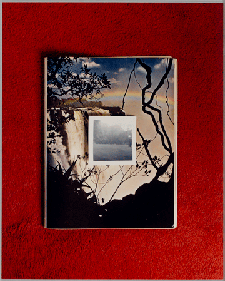 Vanessa Rocco visits Photo-Poetics: An Anthology at the Solomon R. Guggenheim Museum. The “exhibition of ten contemporary photographers” is grounded in the “passionate advocacy of investing time in looking closely at photographs.” As a whole, the works on display were “striking,” though “some individuals and groups were more compelling than others.” Read the full review at caa.reviews.
Vanessa Rocco visits Photo-Poetics: An Anthology at the Solomon R. Guggenheim Museum. The “exhibition of ten contemporary photographers” is grounded in the “passionate advocacy of investing time in looking closely at photographs.” As a whole, the works on display were “striking,” though “some individuals and groups were more compelling than others.” Read the full review at caa.reviews.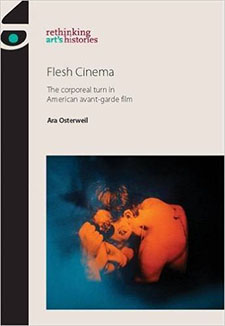 Nicholas C. Morgan reviews the book Flesh Cinema: The Corporeal Turn in American Avant-Garde Film by Ara Osterweil. In “one of the most compelling studies of the body’s relation to avant-garde art and film,” the author “articulate[s] ‘flesh cinema’ as a coherent, if shifting, category of postwar film” and insists “on the impossibility of divorcing ‘flesh cinema’ from the flesh of the world.” Read the full review at caa.reviews.
Nicholas C. Morgan reviews the book Flesh Cinema: The Corporeal Turn in American Avant-Garde Film by Ara Osterweil. In “one of the most compelling studies of the body’s relation to avant-garde art and film,” the author “articulate[s] ‘flesh cinema’ as a coherent, if shifting, category of postwar film” and insists “on the impossibility of divorcing ‘flesh cinema’ from the flesh of the world.” Read the full review at caa.reviews.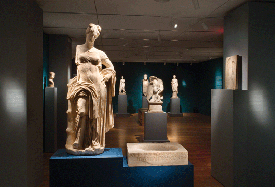 Anne Hrychuck Kontokosta discusses Gods and Mortals at Olympus: Ancient Dion, City of Zeus at the Onassis Cultural Center. The exhibition “delighted viewers with a carefully curated collection” of objects” and “focused on archeological research,” facilitating “a comprehensive and contextualized understanding of the ancient city of Dion.” Read the full review at caa.reviews.
Anne Hrychuck Kontokosta discusses Gods and Mortals at Olympus: Ancient Dion, City of Zeus at the Onassis Cultural Center. The exhibition “delighted viewers with a carefully curated collection” of objects” and “focused on archeological research,” facilitating “a comprehensive and contextualized understanding of the ancient city of Dion.” Read the full review at caa.reviews. Gülru Çakmak reads Gustave Moreau: History Painting, Spirituality, and Symbolism by Peter Cooke. The author traces the artist’s “lifelong endeavor to revitalize le grand art in France … and to combat the endemic materialism of the age,” showing how “the antinaturalist and antidemocratic aesthetic” of Moreau’s work “countered the dominant naturalist paradigm in French art.” Read the full review at caa.reviews.
Gülru Çakmak reads Gustave Moreau: History Painting, Spirituality, and Symbolism by Peter Cooke. The author traces the artist’s “lifelong endeavor to revitalize le grand art in France … and to combat the endemic materialism of the age,” showing how “the antinaturalist and antidemocratic aesthetic” of Moreau’s work “countered the dominant naturalist paradigm in French art.” Read the full review at caa.reviews.Serve on a CAA Award Jury
posted by tiffany — March 16, 2017
CAA invites nominations and self-nominations for individuals to serve on seven of the twelve juries for the annual Awards for Distinction for three years (2017–20). Terms begin in May 2017; award years are 2018–20. CAA’s twelve awards honor artists, art historians, authors, curators, critics, and teachers whose accomplishments transcend their individual disciplines and contribute to the profession as a whole and to the world at large.
Candidates must possess expertise appropriate to the jury’s work and be current CAA members. They should not hold a position on a CAA committee or editorial board beyond May 31, 2017. CAA’s president and vice president for committees appoint jury members for service.
Jury vacancies for spring 2017:
- Alfred H. Barr Jr. Award: two members
- Artist Award for a Distinguished Body of Work: two members
- CAA/AIC Award for Distinction in Scholarship and Conservation: one member
- Distinguished Feminist Award: two members
- Distinguished Lifetime Achievement Award for Writing on Art: one member
- Distinguished Teaching of Art History Award: one member
- Frank Jewett Mather Award: two members
Nominations and self-nominations should include a brief statement (no more than 150 words) outlining the individual’s qualifications and experience and a CV (an abbreviated CV no more than two pages, may be submitted). Please send all materials by email to Katie Apsey, CAA manager of programs; submissions must be sent as Microsoft Word or Adobe PDF attachments. For questions about jury service and responsibilities, contact Tiffany Dugan, CAA director of programs.
Deadline Extended: May 31, 2017.
Statement on the US President’s FY2018 Budget Proposal
posted by CAA — March 16, 2017
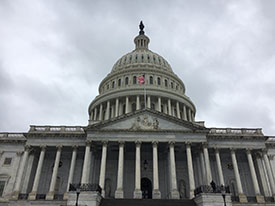 Today the US President released his proposal for 2018 federal budget – it envisions transferring additional billions of dollars to the Department of Defense, Veterans Affairs, and Homeland Security from many important domestic programs such as the Environmental Protection Agency, education, and legal services. As expected, the budget also calls for the complete elimination of the Corporation for Public Broadcasting, National Endowment for the Arts, National Endowment for the Humanities, and 16 other federal agencies. CAA was one of the first national organizations to speak against these cuts.
Today the US President released his proposal for 2018 federal budget – it envisions transferring additional billions of dollars to the Department of Defense, Veterans Affairs, and Homeland Security from many important domestic programs such as the Environmental Protection Agency, education, and legal services. As expected, the budget also calls for the complete elimination of the Corporation for Public Broadcasting, National Endowment for the Arts, National Endowment for the Humanities, and 16 other federal agencies. CAA was one of the first national organizations to speak against these cuts.
Read the statement against these cuts that CAA released on January 23, 2017.
As educators, art historians, artists, curators, museum directors, designers, scholars, and other members of the visual arts community we must act to defend the role of arts and humanities in our society. The budget process is long and ultimately controlled by the US House and Senate. Earlier this week, CAA traveled to Washington for Humanities Advocacy Day to meet with many congressional offices to discuss the importance of continued NEA and NEH funding. We will return again next week to do the same for Arts Advocacy Day.
In addition, CAA assembled an Arts and Humanities Advocacy Toolkit with information on how to contact your representatives in Congress to voice your support for the NEA and NEH and the many quality programs they fund. Call their offices. Email them. Attend Town Halls. You can learn how these agencies support activities in your area here: funded by the NEA and funded by the NEH. Be sure to let your representatives know of the impact of the arts and humanities in your districts. Spread the word to your colleagues and friends.
Despite the White House’s opposition to continued funding for the NEA and NEH, there is sufficient reason to believe that many members of the US House and Senate will support a budget that includes continued funding for these agencies. I ask our members to join in the effort to make sure all members of Congress knows the importance of the work done by these agencies.
![]()
Hunter O’Hanian
Executive Director
Chief Executive Officer


